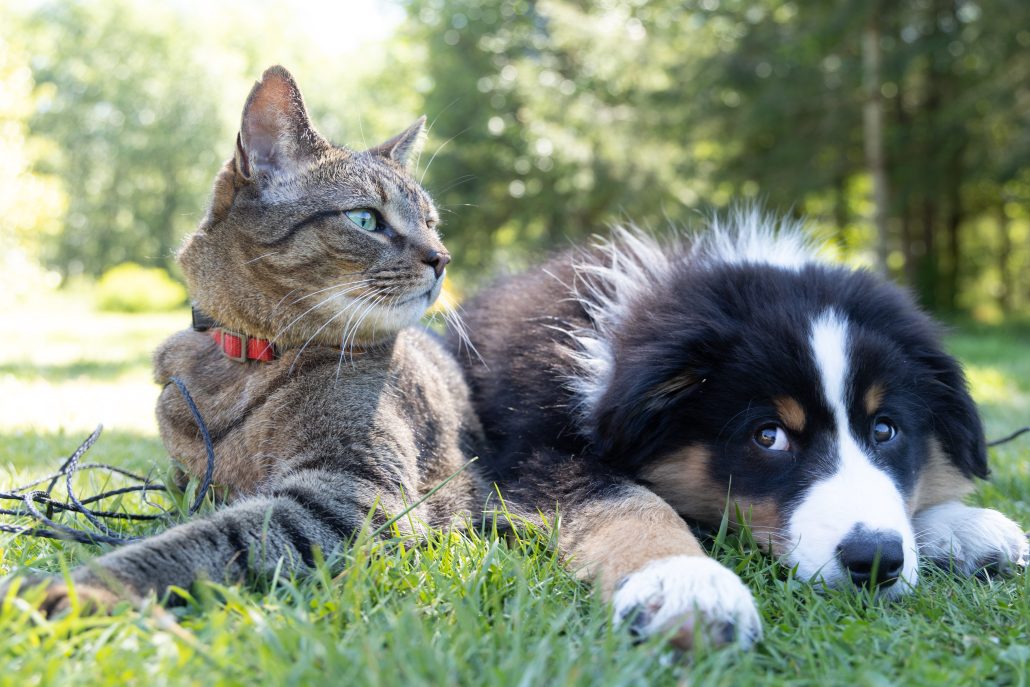As the temperatures begin to warm and the colours of nature start to bloom across Australia, Spring sees a boost in our energy levels. It is a time for pets to frolic outdoors, soak up the sun, and take on new activities!
However, amidst the blossoms and warm breezes, there’s an often-overlooked concern that can affect our furry companions – springtime allergies. Just like us, pets can suffer from allergies triggered by the new season, causing discomfort and distress.
In this latest post, we discuss what you need to know about seasonal allergies in your pets, equipping you with the knowledge and strategies needed to help your four-legged friends enjoy a happy and healthy spring. From understanding the various types of allergies to identifying their symptoms and implementing proactive management strategies, we’ve got you covered!

What Causes Seasonal Allergies?
From leisurely strolls around the neighbourhood to intensive hikes and exciting beach days, Springtime is one of the best seasons for outdoor activities with your pet. As the days are warmer but not excessively hot, it is a great was to shed any excess weight gained over winter, boost their metabolism and get some much needed exercise.
Unfortunately, with Spring comes some uncomfortable hazards. Some of the most common include:
- Pollen levels: While Spring is know for renewal and growth, it is also notorious for pollen production. While these tiny particles are essential for plant reproduction, they can wreak havoc on your pet’s respiratory system. Pollen allergies are a common concern during this season, leading to sneezing, runny noses, and itchy eyes in both humans and pets.
- Spring pests and parasites: Spring (and Summer) is also the breeding season for many pest and parasites such as ticks, fleas and heartworm. Not only do they cause irritation and skin discomfort, but these pests carry deadly diseases such as paralysis and tick bit fever, making prevention essential during this time of year. Similarly, bees and wasps are out in full force in Spring and can cause irritation and swelling in pets if stung.
- Common allergens: Apart from pollen, there are other common allergens that become more prevalent in spring. Dust mites thrive in warmer conditions, and their presence can exacerbate allergies in pets. Additionally, moulds tend to grow in damp areas, which can also cause irritation and respiratory issues.

Understanding Spring Time: Common Signs & Symptoms of Pet allergies
Understanding the signs and symptoms of these allergies is crucial in ensuring your furry friend’s well-being during this vibrant season. For many of our pets, the first signs they are suffering from a spring or seasonal allergy is through red and itchy skin. However, if not treated properly, can lead to more serious issues such as painful sores and infections that will require prompt treatment. The most common signs of seasonal spring allergies include:
Skin Irritation & Itchiness
Excessive itching and scratching are often the first signs of allergies in pets. You might notice your pet relentlessly scratching various parts of their body, leading to redness and discomfort.
Hair Loss:
Allergic reactions can cause hair loss in localized areas, giving your pet’s coat a patchy appearance. This hair loss is usually a result of their persistent scratching and overgrooming.
Red Sores
The continuous scratching and biting can lead to the formation of red, inflamed sores on your pet’s skin. These sores can be painful and may become infected if not treated promptly.
Ear Infections:
Allergies can contribute to ear problems in pets. Watch for signs like constant head shaking, ear discharge, or a foul odour emanating from their ears.
Runny Nose & Watery Eyes
Just like in humans, allergies can cause your pet’s nose to run and their eyes to water. You might notice them sneezing or pawing at their face.
Chewing & Licking
Pets often try to alleviate their discomfort by chewing or licking their paws or underbelly excessively. This behaviour can result in further skin irritation, redness and pain.
Distinguishing between spring allergies and other health issues in your pet can be a bit challenging, as some symptoms may overlap. However, there are specific cues that can help you determine if your furry friend is grappling with allergies or facing a different concern.
The most important is to pay attention to when the symptoms occur. If your pet’s issues tend to manifest mainly during spring or when pollen levels are high, it’s a strong indicator of seasonal allergies. If you are unsure whether it is a seasonal allergy or another issue, be sure to make an appointment with your local vet. They will have the skills and knowledge to accurately identify, diagnose and treat your companion and ensure they stay happy and healthy.

Prevention & Allergy Management
Seasonal allergies in pets can be managed effectively through a combination of preventive measures and appropriate treatments. Here’s a comprehensive look at how you can ensure your pet enjoys a comfortable spring:
Creating an Allergy-Friendly Environment
Minimise the presence of allergens indoors by regularly cleaning and vacuuming. Use high-efficiency particulate air filters in your home is also a great way to trap pollen and dust particles. Additionally, regularly washing your pet’s bedding and toys to can remove allergens and prevent allergic reactions.
Seasonal Pet Grooming
Regular grooming is key to managing spring allergies in pets. Brush your pet’s coat frequently to remove pollen and other allergens that may have accumulated. Consider professional grooming if your pet has long or thick fur that’s difficult to manage.
Dietary Considerations
In some cases, allergies can be triggered or exacerbated by certain ingredients in their food. Your vet may recommend a special diet or allergy-friendly pet food to help manage and prevent allergic reactions.
Natural Remedies
You can also explore natural remedies to complement your pet’s allergy management plan. Some pet owners find relief for their pets through holistic approaches, herbal remedies, and alternative therapies. However, always consult your vet before trying any natural remedies to ensure they are safe and suitable for your pet.
Is It Safe to Use Human Allergy Medications?
Avoid using over-the-counter human allergy medications for your pet without consulting your veterinarian first. Some human medications can be toxic to animals or have adverse side effects.
Medications and Treatments
If your pet’s allergies are severe, your veterinarian may recommend medications or treatments to alleviate their symptoms. These can include antihistamines, corticosteroids, or immunotherapy. However, it is always important to follow your vet’s instructions when administering medications to your pet.
By implementing these strategies, you can create a safer and more comfortable environment for your pet during the spring season and help them enjoy this beautiful time of year to the fullest!
Read More: Secrets To A Stress Free Vet Visit

Spring Into Seasonal Allergy Management!
With the joys of spring, come a variety of challenges for our beloved pets. From understanding the common triggers to recognising the signs and symptoms of spring allergies, you can take a proactive approach in safeguarding your pet’s health.
For expert guidance and care, consider reaching out to The House Call Vet. We are your trusted partner in pet health and allergy management. Our experienced veterinary professionals are here to help you navigate the challenges of springtime allergies and ensure your pet enjoys this season to the fullest!
By embracing these proactive measures and partnering with The House Call Vet, you can make this spring a memorable and allergy-free experience for your furry family members! Get in touch today!

